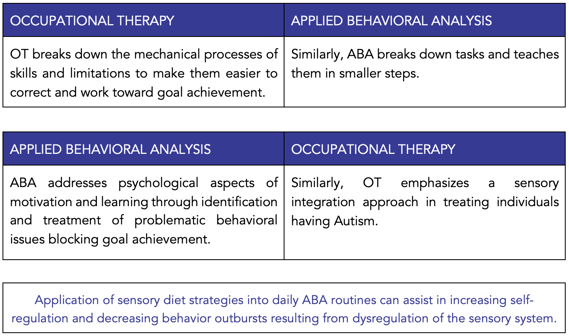HealthPRO Pediatrics has been providing therapy services for children of all ages for 35+ years. In 2020, our partnership with Alternatives ABA – a multi-specialty clinical practice specializing in the treatment of autism spectrum disorder – took our offerings to another level by adding Applied Behavior Analysis (ABA) to our roster.
Collaboration Across Disciplines
Alternatives ABA offers both ABA + Occupational Therapy (OT) services in an outpatient clinic setting treating primarily kids having Autism Spectrum Disorder (ASD). Having all therapies in one location improves a child’s success because the therapists can be in constant communication about the child’s therapy plan and progress. Often, a child’s behavior analyst or therapist will go with them to their occupational therapy and get to observe their session. This not only allows them to monitor the child’s behavior in sessions and provide useful strategies for the occupational therapist, but also allows the behavior therapist to gain hands-on experience with that child’s goals which can then be carried over into ABA sessions. Each child’s treatment plan is individually tailored to focus on improving the building blocks needed to achieve success in their daily activities. OT + ABA work together to emphasize a family-based approach to treatment, collaborating with children and their families to help kids reach personal goals and developmental milestones through a fun, play-based approach.
Working Together to Improve Life Skills
OT is used in conjunction with ABA in order to help clients improve overall quality of life. While the fields of OT and ABA address similar life skill areas (self-care, self-regulation, motor skills), the methodologies used to learn and obtain these skills differ between disciplines. Here is a bit of history on the development of both disciplines:
Occupational Therapy: evidence-based practice designed to help individuals acquire or regain the skills needed to perform the activities—or “occupations”—of daily life. For children, these activities of daily living include tasks such as dressing, self-feeding, handwriting, and playing on the playground with peers. These underlying “building block” skills include fine motor skills, gross motor coordination, bilateral integration, motor planning, sensory processing, body and spatial awareness, visual-perceptual skills, postural control and stability, and self-regulation.
HISTORY OF OT: Click here for a recap of key moments in the history of OT!
Applied Behavior Analysis (ABA) is the process of systematically applying interventions based upon the principles of learning theory to improve socially significant behaviors to a meaningful degree, and to demonstrate that the interventions employed are responsible for the improvement in behavior.
HISTORY OF ABA: Click here to view major points of note in the history of ABA!
Collaboration Across Disciplines
Both OT and ABA are highly goal-oriented and place primary focus of treatment of individuals with ASD on teaching appropriate skills and behavior to improve quality of life and socialization.
Let’s dig deeper into how OT + ABA work in conjunction:
Because many issues faced by ASD clients are multi-spectrum, involving both sensory and behavioral issues, using a cross-disciplinary treatment approach sets our clients up for the greatest success. ABAs are specifically trained to look for reinforcement techniques and opportunities. Applying that training to the practice of OT as a way to increase the performance of age-appropriate self-care, learning, and play tasks results in much faster improvement than using either process independently. At Alternatives ABA, our staff are in constant communication regarding the best treatment strategies and plans for our kids. We strive to work collaboratively across disciplines every day to set our kids and their families up for success, satisfaction, and increased quality of life. We’ve seen remarkable results when we all work together!
Author: Stephanie Fitzgerald, MS, OTR/L
Stephanie graduated from Massachusetts College of Pharmacy and Health Sciences University in 2018 with a Master of Science in Occupational Therapy degree. While at MCPHS University, she completed her pediatric fieldwork at Nemours Children’s Hospital, where she provided OT services to children in the outpatient and autism diagnosis clinics. Stephanie loves working with the pediatric population and before becoming an OT worked as an ABA behavior technician and a special education teacher assistant. In her free time Stephanie enjoys working out, playing with her dog, traveling, and spending time with family and friends!
REFERENCES:
“ABA in Conjunction with Occupational Therapy.” Applied Behavior Analysis Programs Guide, 1 Sept. 2018, www.appliedbehavioranalysisprograms.com/specialties/aba-occupational-therapy/.
“Applied Behavior Analysis and Occupational Therapy.” Applied Behavioral Analysis Edu, AppliedBehaviorAnalysisEdu.org, 26 Jan. 2017, www.appliedbehavioranalysisedu.org/occupational-therapy/.
Gilmore, Heather. “Brief History of Applied Behavior Analysis.” Psych Central, Scientific Advisory Board, 8 Feb. 2019, psychcentral.com/pro/child-therapist/2019/02/brief-history-of-applied-behavior-analysis#1.
“Occupational Therapy: A Brief History.” Collection Spotlight from the National Rehabilitation Information Center, National Rehabilitation Information Center, 8 Nov. 2018, naricspotlight.wordpress.com/2018/11/09/occupational-therapy-a-brief-history/.
“Occupational Therapy: The History and Benefits.” Performance by Danielle Jobin, YouTube, St. Peter's Health Partners, 18 Apr. 2019, www.youtube.com/watch?v=okq4Ut95zFg.
Reitz, S. Maggie. “A Historical Review of Occupational Therapy's Role in Preventive Health and Wellness.” The American Journal 0/ Occupational Therapy, vol. 46, no. 1, Jan. 1992, pp. 50–55.


